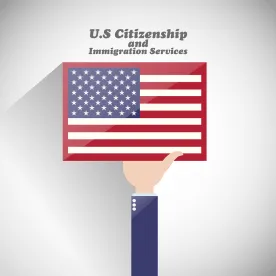On September 3, 2020, U.S. Citizenship and Immigration Services (“USCIS”) submitted an interim final rule (“IFR”) titled “Strengthening the H-1B Nonimmigrant Visa Classification Program.” As a result of submitting an IFR, rather than a Notice of Proposed Rulemaking (“NPRM”), the regulation will take effect upon publication without public comment.
Traditionally, a new regulation is required to go through the NPRM process, which includes the publishing of a proposed rule followed by a comment period of at least 30 to 60 days. After the comment period is closed and comments are reviewed, an agency is then able to publish a final rule with an effective date of no less than 30 days after publication.
In contrast, an IFR is published as a final rule that becomes effective without the agency first evaluating and responding to public comments. Please note that most regulations that are IFRs allow for public comments at a later date, but an IFR goes into effect on an interim basis before comments are provided and reviewed. An IFR can be issued in advance and comments required afterwards when there is good cause to do so. Good cause means that it is “impracticable, unnecessary, or contrary to the public interest” to go through the normal NPRM process.
Submission of any rule must go through the Office of Management and Budget (“OMB”) before being put into regulation. Because the USCIS IFR has been put on a fast track by the current administration, it will be published by the OMB on October 8, 2020. The USCIS IFR will take effect in 60 days from its October 8, 2020, publication in the Federal Register.
The U.S. Department of Labor (“DOL”) IFR titled “Restructuring of H-1B/H-1B1/E-3 and PERM Wage Levels” will take effect on October 8, 2020. Both of these IFRs are expected to substantially modify and increase prevailing wages and their requirements to limit the H-1B program to the most highly paid professionals, regardless of actual prevailing wage labor market data.
A summary of these IFRs is as follows:
-
An updated definition of an H-1B specialty occupation to “increase focus on obtaining the best and brightest foreign nationals.” This means USCIS will be adjudicating H-1B petitions with a stricter scrutiny to confirm that the offered position meets H-1B employee’s qualifications exactly. For example, if the position is a software engineer, then USCIS will have no issues if the H-1B employee possesses at least a bachelor’s degree in Computer Science or Engineering. But if the employee possesses a general engineering degree, such as Industrial or Mechanical Engineering, then the H-1B petition could be denied.
-
Changes to the H-1B employer-employee relationship that restricts offsite H-1B employment based on third-party placement of H-1B workers.
-
More restrictive requirements involving H-1B employers who assign their H-1B employees to third-party end-client sites.
-
Additional H-1B wage requirements to be determined “to ensure employers pay appropriate wages to H-1B visa holders” as well as a restructuring of the H-1B, H-1B1, and E-3, as well as PERM prevailing wage levels.
These expected changes are likely to be inconsistent with existing statutes on H-1B specialty occupation. As a result, these IFRs are ripe for immediate lawsuits. We will advise if and when such lawsuits are filed and to what extent they will impact or prevent these IFRs from being implemented.
Federal Court Halts USCIS’s Filing Fee Increases
A new final rule by USCIS, which would increase filing fees and require the use of new versions of several forms (“Final Rule”), was scheduled to take effect on October 2, 2020.
However, on September 29, 2020, the U.S. District Court of the Northern District of California (in Immigrant Legal Resource Center v. Wolf, 20-cv-05883-JSW) issued a preliminary injunction and stay halting implementation of the Final Rule in its entirety pending final adjudication of the fee increases and form changes. The case was brought against USCIS by eight nonprofit agencies (the Asian Counseling and Referral Service; the Catholic Legal Immigration Network, Inc.; the Coalition for Human Immigrant Rights; the East Bay Sanctuary Covenant; the Illinois Coalition for Immigrant and Refugee Rights; the Immigrant Legal Resource Center; the International Rescue Committee; and OneAmerica) questioning the legality of the Final Rule. At this time, it is unclear how long the Final Rule will remain enjoined. USCIS has 60 days to appeal the decision. For now, all filing fees and forms remain unaffected by the Final Rule.
Court Blocks Trump Administration’s Foreign Worker Ban on
H-1B and L-1 Visa Applicants
On April 22, 2020, in response to the COVID-19 pandemic, President Trump signed Proclamation 10014 (“Presidential Proclamation”), suspending entry into the United States of certain nonimmigrants in the H-1B, H-2B, J, and L categories, along with their spouses and children, through December 31, 2020. The Presidential Proclamation did not revoke valid visas. However, anyone who did not hold a valid visa or was not in the United States on such status as of June 24, 2020, is not eligible for a visa until the order is lifted next year. Please see our July 2020 Immigration Alert for information regarding amendments to the Presidential Proclamation.
On October 1, 2020, a federal court (in National Association of Manufacturers v. U.S. Department of Homeland Security) granted a motion for preliminary injunction to stop the government from enforcing the visa ban while the court makes a final decision on the case.
The preliminary injunction benefits only the plaintiffs of the case, the U.S. Chamber of Commerce and the National Retail Federation, as well as a company operating J-1 cultural exchange programs and the hundreds of thousands of businesses that are members of those associations. Visa applicants who have no connection or membership to the plaintiffs in this lawsuit remain subject to the Presidential Proclamation. At this time, it is unclear how the U.S. Department of State (“DOS”) and the Department of Homeland Security will identify eligible plaintiffs to comply with the preliminary injunction order authorizing issuance of H-1B, H-2B, J, and L visas. The DOS’s only response came on October 2, 2020, when it issued a press release stating, “Per the California federal court’s order … PP 10052 will not be taken into account in making emergency appointments. The Department is in the process of updating guidance on individual embassy and consulate websites.”
President Trump Signs Bill Expanding Premium Processing
On September 30, 2020, Congress passed and the President signed a bill, HR 8337, which greatly expands the scope of USCIS’s premium processing services. Currently, USCIS will accept premium processing requests to fast-track agency review and case decision within 15 calendar days for select employment-based petitions filed with USCIS. Normal processing of these petitions can take several months to over a year. HR 8337 expands the premium processing service to include additional petitions/applications as follows:
-
EB-1(c) I-140 petitions for Multinational Managers and Executives, and EB-2 I-140 petitions for National Interest Waiver petitions.
-
F, J, and M I-539 applications.
-
Family derivative E, H-4, L-2, O-3, P, and R I-539 visa applications.
-
All Form I-765 EAD Work Permit Applications.
However, the new law also has a couple of negative consequences. First, the current $1,440 premium processing filing fee will be increased to $2,500. Second, the premium processing adjudication time will be extended to 30-45 days, instead of the 15-calendar days for new applications and petitions eligible for premium processing under the new law. Further clarification and USCIS policy on implementation of the new law will follow in the near future.
DOS Updates October 2020 Visa Bulletin, Resulting in
Increased Permanent Residency Filings
The DOS published its October 2020 visa bulletin with updated priority dates for the new fiscal year. The DOS has drastically advanced both the China- and India-born employment-based Third Preference Category (“EB-3”) priority dates. Moreover, immediately after the DOS announced its October 2020 visa bulletin, USCIS announced that it will accept applications for permanent residency (i.e., I-485 application for Adjustment of Status) using the Date of Filingchart instead of the Final Action Date chart. The October 2020 visa bulletin and the USCIS announcement will drastically increase I-485 application filings by eligible applicants. The high volume of permanent residency applications could affect future visa bulletins or USCIS’s temporary acceptance of the Date of Filing chart. The priority dates could easily retrogress in November, and USCIS could revert back to accepting only the Final Action Date chart, which has historically been unfavorable when compared to the Date of Filing chart.
The Office of Foreign Labor Certification Will Permanently Issue
Electronic PERM Labor Certifications
On September 25, 2020, the Office of Foreign Labor Certification (“OFLC”) announced that it will permanently adopt the electronic issuance of PERM Labor Certifications to employers (and their authorized attorneys or agents). Back on March 24, 2020, due to the COVID-19 pandemic, the OFLC announced that it would electronically issue PERM Labor Certifications through June 30, 2020, which was later extended to September 30, 2020. The OFLC has now made this practice permanent.
USCIS Reminds E-Verify-Registered Employers to Strictly Follow
Tentative Nonconfirmation Requirements
USCIS announced, on its website, that beginning November 5, 2020, it will begin warning E-Verify-registered employers of their requirements to comply with E-Verify procedures within 10 days of receiving a Tentative Nonconfirmation (“TNC”) of newly hired employee(s) whose work authorization could not be confirmed through E-Verify.
A TNC case not acted upon infers that an employer is either (1) not referring the employee(s) to correct the TNC with the appropriate U.S. government agency (i.e., the Social Security Administration or the Department of Homeland Security) or (2) not closing the TNC case when an employee chooses not to resolve the TNC. Both of these inactions are E-Verify violations and grounds for USCIS to terminate the employer’s E-Verify registration.




 />i
/>i

